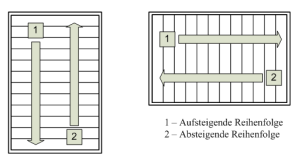Equippable component types
The component types of the categories Network element, Card/Module, Container/Cabinet, Shaft and Duct/Route are component types into which elements can be integrated. For this reason, these are summarised as equippable component types in the following section. The terms and characteristics explained below are hence used for all these component types.
In a equippable component type, component types can be placed in slots/channels (duct), which are configured on a maximum of 2 levels in rows/segments (duct). Slots can be given any name. |
The 2 levels on which the rows and slots are located are designated as: •1. Level: Card layer •2. Level: Backplane layer The level subdivision has an effect on the component level.
|
The subdivision into slots/channels per row/segment defines the graphical representation of the aggregate component types. The user can still additionally define whether they should have a horizontal or vertical orientation. |
Besides the orientation, the user can still specify whether the first slot should be positioned at the beginning or the end of the row: •01…10: •10…01:
|
Various additional control functions are available for aggregate component types: •Useful slot utilisation •Only defined component types •Maximum number for each component type •Static component type •Automatic generation template |
The slot utilisation function indicates how many slots/channels are included in a component type. If the slot utilisation function is deactivated, every component type can only include one useful slot.
|
In the case of an equippable component type, the user can specify a list of component types that may be included in it. These component types are designated as element types, and for component types of the category Network element, as card/module types. If the control function only defined component types is activated, only the element type/card types are available for positioning. |
For each element type/card type, a maximum number can be defined, which specifies the maximum number of component types of this element type/card type that may be included in the container.
|
If a component type is defined as static, it means that when a component of this type is generated, components within the component type are created in the background according to the equipment template. These components included in the component are fixed; the user may neither add new ones, remove any nor change their position. Only names may be changed. |
It is possible to define in which slots which component type is placed (several slots can be used) in the equipment template. If a component type is created automatically, components of exactly this component type can be generated in the slots according to the equipment template.
|

